The Archives
-
No Compromise, Periodicals
No Compromise #23-26
02.17.13 | PermalinkNo Compromise 23-26 (2004, Santa Cruz / San Francisco, CA)
One of the lessons that archiving old animal liberation publications has taught me is that the most extreme actions have rarely produced much in the way of results for animals. A public that already sees veganism as odd might still see the value of rescuing animals from a laboratory, but will never support a car bombing. When innocents are injured, or when murder was the goal, the backlash starts to creep into our own ranks, and as we fracture law enforcement and industry groups take advantage. In the end, I can think of no bombing (or contamination, or grave robbing, etc.) which advanced the cause of animal rights more than it harmed it. This is not to say that bombings and the like could never be successful. At later stages of many revolutionary struggles, when the majority of the public supports the cause, bombs can clear away in one night what years of protest could not. While a movement is in its infancy, however, it could be argued that more often than not bombs blow up in our faces.
And so it was in 2004 when a group calling itself the Revolutionary Cells Animal Liberation Brigade carried out two bombings of HLS related targets in California. The movement was left to make lemonade from truly shitty lemons, and No Compromise did their best to mitigate the harm of the actions while keeping activists focused on the real enemy.
The year continued with the indictment of the SHAC 7, the emergence of Austria as a leader in the movement, and some exciting open rescues. Sarahjane Blum and Ryan Shapiro’s organization, GourmetCruelty.com, carried out one such operation that piqued public interest and eventually resulted in a sympathetic program on Animal Planet. Elsewhere Gina Lynn was imprisoned for defying the Seattle grand jury, Billy Cottrell was arrested for a massive SUV dealership arson, and the Universtiy of Iowa was treated to the most sophisticated lab raid to occur since the early 90s.
Every time we post a year of No Compromise we say the same thing: that this is essential reading for those who wish to understand the recent history of our movement. This posting is no exception. No Compromise was the best AR publication of its era, and 2004 saw the publication refining its strengths and providing their readers with four of the best issues yet.
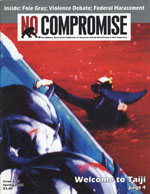



-
Periodicals
Liberate!
11.06.12 | PermalinkLiberate! #1-7 (1996-1997 Birkenhead, New Zealand)
Liberate! was published by Auckland Animal Action, one of the dozens of militant organizations that suddenly coalesced in the mid-90s. While the activities of the group itself were fairly moderate, the visual direction and rhetoric of the magazine was quite extreme. In it’s era this was appropriate. In these modern days of soy milk in every cafe and vegan cheese in every supermarket, talking about cutting off the fingers of vivisectors is certainly going to frighten away an audience that is already coming around. It wasn’t very long ago, however, that the late 80’s trend of moderation in activism was a clear failure. Dialogue about violence and sabotage was a necessary component of moving forward, and it is important to note that these discussions, thankfully, didn’t result in any missing digits.
Liberate! was not particularly well written, but there are some stand out articles about the burgeoning pro-direct action grassroots, conflicts between environmentalists and animal liberationists, and some entertaining imagery as well. Also of interest, given the current Canadian “Marineland Animal Defense” campaign, are the details of New Zealand’s 90s campaign against their own Marineland.
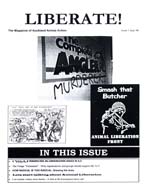
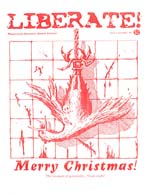
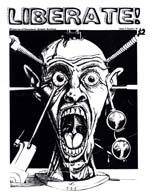
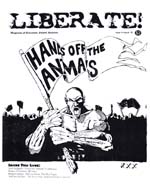
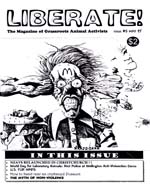
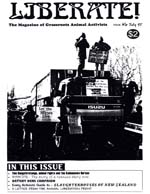
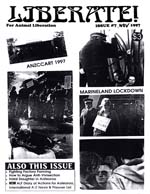
-
No Compromise, Periodicals
No Compromise #6-7
08.23.11 | PermalinkNo Compromise #6-7 (1997. Minneapolis, MN.)
The second year of No Compromise was packed with inspiring coverage of the growth of the militant grassroots, including some of the most important events of the 90s: Tony Wong’s hunger strike, the mass arrests and police riot at the Yerkes primate center, and the World Week for Animals in Laboratories arrests at the UC Davis primate center.
Tony Wong was only 16 years old when he was convicted for a civil disobedience action at the Lazurus department store. He immediately began a hungerstrike in prison, and after a month of not eating the staff at the juvenile facility where he was being held began force feeding him animal products through a tube forcefully inserted through his nose. The brutality faced by Tony acted as a lightning rod, and soon large demonstrations and acts of sabotage rippled across the country. The most important thing that Tony did though was to set an example of dedication that others could admire and aspire to in their own lives. Sadly, Tony eventually embraced a deeply speciesist political transformation and began consuming animals again after sacrificing so much to save them.
World Week in 1997 saw miniature police riots in Georgia and California. The protests themselves were not as important as the resulting boost to the movement created by the heavy handedness of the cops. As van loads of activists traveled to these demonstrations and found themselves sharing jail cells with like minded comrades, they soon formed tighter networks which led to greater revolutionary potential. The west coast and east coast both saw an upswing in regional actions after these arrests.
No Compromise was plagued by it’s usual production and distribution delays this year. It only got two issues finished, and they didn’t make it into people’s hands on the advertised cover dates, but both of these issues are wonderful documents of their era.
No Compromise #1-5 can be found here.
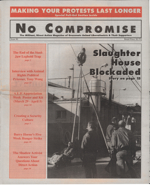
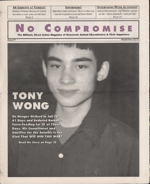
…




